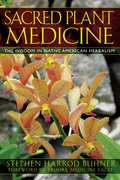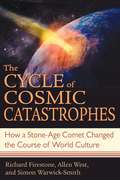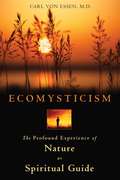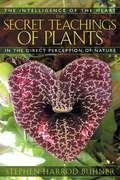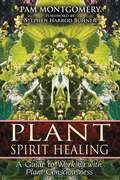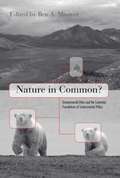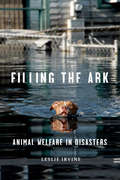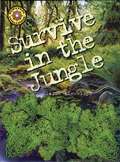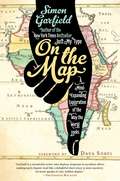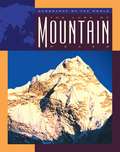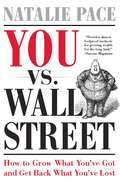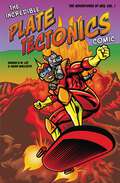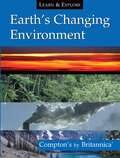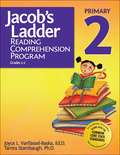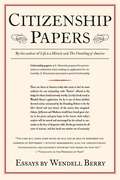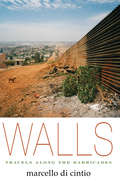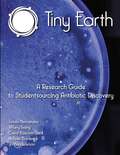- Table View
- List View
Sacred Plant Medicine: The Wisdom in Native American Herbalism
by Brooke Medicine Eagle Stephen Harrod BuhnerThe first in-depth examination of the sacred underpinnings of the world of Native American medicinal herbalism• Reveals how shamans and healers “talk” with plants to discover their medicinal properties• Includes the prayers and medicine songs associated with each of the plants examined• By the author of The Secret Teachings of PlantsAs humans evolved on Earth they used plants for everything imaginable--food, weapons, baskets, clothes, shelter, and medicine. Indigenous peoples the world over have been able to gather knowledge of plant uses by communicating directly with plants and honoring the sacred relationship between themselves and the plant world. In Sacred Plant Medicine Stephen Harrod Buhner looks at the long-standing relationship between indigenous peoples and plants and examines the techniques and states of mind these cultures use to communicate with the plant world. He explores the sacred dimension of plant and human interactions and the territory where plants are an expression of Spirit. For each healing plant described in the book, Buhner presents medicinal uses, preparatory guidelines, and ceremonial elements such as prayers and medicine songs associated with its use.
The Cycle of Cosmic Catastrophes: How a Stone-Age Comet Changed the Course of World Culture
by Allen West Richard Firestone Simon Warwick-SmithNewly discovered scientific proof validating the legends and myths of ancient floods, fires, and weather extremes• Presents new scientific evidence revealing the cause of the end of the last ice age and the cycles of geological events and species extinctions that followed• Connects physical data to the dramatic earth changes recounted in oral traditions around the world • Describes the impending danger from a continuing cycle of catastrophes and extinctionsThere are a number of puzzling mysteries in the history of Earth that have yet to be satisfactorily explained by mainstream science: the extinction of the dinosaurs, the vanishing of ancient Indian tribes, the formation of the mysterious Carolina Bays, the disappearance of the mammoths, the sudden ending of the last Ice Age, and the cause of huge underwater landslides that sent massive tsunamis racing across the oceans millennia ago. Eyewitness accounts of these events are chronicled in rich oral traditions handed down through generations of native peoples. The authors’ recent scientific discoveries link all these events to a single cause.In The Cycle of Cosmic Catastrophes Richard Firestone, Allen West, and Simon Warwick-Smith present new scientific evidence about a series of prehistoric cosmic events that explains why the last Ice Age ended so abruptly. Their findings validate the ubiquitous legends and myths of floods, fires, and weather extremes passed down by our ancestors and show how these legendary events relate to each other. Their findings also support the idea that we are entering a thousand-year cycle of increasing danger and possibly a new cycle of extinctions.
Ecomysticism: The Profound Experience of Nature as Spiritual Guide
by Carl Von EssenExplores the philosophy, science, and spirituality of nature mysticism and its Green calling • Offers a solid bridge between spiritual practice and environmental activism • Reveals how we can heal the environment by renewing our connection to it • Shows how spiritual encounters in nature are healing the Nature Deficit Disorder of our psyches and bodies Many have been struck by a majestic moment in nature--a sole illuminated flower in a shady grove, an owl swooping silently across a wooded path, or an infinitely starry sky--and found themselves in a state of expanded awareness so profound they can feel the interconnectedness of all life. These trance-like moments of clarity, unity, and wonder often incite a call to protect and preserve the earth--to support Nature as she supports us. Termed “nature mysticism,” people from all cultures have described such experiences. However, the ever-increasing urbanization of the world’s population is threatening this ancient connection as well as the earth itself. In Ecomysticism, Carl von Essen explores nature mysticism through the recorded experiences of outdoor enthusiasts as well as scientific studies in biology, psychology, and neuroscience. Citing consciousness scholar William James and a variety of well-known nature lovers such as Ansel Adams, Henry David Thoreau, and Ralph Waldo Emerson, von Essen shows how the spiritual transcendence from an encounter in nature--like other mystical experiences--is healing the Nature Deficit Disorder of our psyches and bodies, leading to an expansion of our worldview and a clearer understanding of our self and of our natural world. Offering a solid bridge between spiritual practice and environmental activism, von Essen’s spiritual ecology reveals how only through a renewal of humanity’s spiritual connection to nature can we effect true environmental healing.
The Secret Teachings of Plants: The Intelligence of the Heart in the Direct Perception of Nature
by Stephen Harrod BuhnerReveals the use of direct perception in understanding Nature, medicinal plants, and the healing of human disease• Explores the techniques used by indigenous and Western peoples to learn directly from the plants themselves, including those of Henry David Thoreau, Goethe, and Masanobu Fukuoka, author of The One Straw Revolution• Contains leading-edge information on the heart as an organ of perceptionAll ancient and indigenous peoples insisted their knowledge of plant medicines came from the plants themselves and not through trial-and-error experimentation. Less well known is that many Western peoples made this same assertion. There are, in fact, two modes of cognition available to all human beings--the brain-based linear and the heart-based holistic. The heart-centered mode of perception can be exceptionally accurate and detailed in its information gathering capacities if, as indigenous and ancient peoples asserted, the heart’s ability as an organ of perception is developed.Author Stephen Harrod Buhner explores this second mode of perception in great detail through the work of numerous remarkable people, from Luther Burbank, who cultivated the majority of food plants we now take for granted, to the great German poet and scientist Goethe and his studies of the metamorphosis of plants. Buhner explores the commonalities among these individuals in their approach to learning from the plant world and outlines the specific steps involved. Readers will gain the tools necessary to gather information directly from the heart of Nature, to directly learn the medicinal uses of plants, to engage in diagnosis of disease, and to understand the soul-making process that such deep connection with the world engenders.
Plant Spirit Healing: A Guide to Working with Plant Consciousness
by Stephen Harrod Buhner Pam MontgomeryA hands-on approach to working with the healing powers of plant spirits • Explores the scientific basis underlying the practices of indigenous healers and shamans • Illuminates the matrix where plant intelligence and human intelligence join • Reveals that partnering with plants is an evolutionary imperative Indigenous healers and shamans have known since antiquity that plants possess a spirit essence that can communicate through light, sound, and vibration. Now scientific studies are verifying this understanding. Plant Spirit Healing reveals the power of plant spirits to join with human intelligence to bring about profound healing. These spirits take us beyond mere symptomatic treatment to aligning us with the vast web of nature. Plants are more than their chemical constituents. They are intelligent beings that have the capacity to raise consciousness to a level where true healing can take place.In this book, herbalist Pam Montgomery offers an understanding of the origins of disease and the therapeutic use of plant spirits to bring balance and healing. She offers a process engaging heart, soul, and spirit that she calls the triple spiral path. In our modern existence, we are increasingly challenged with broken hearts, souls in exile, and malnourished spirits. By working through the heart, we connect with the soul and gain access to spirit. She explains that the evolution of plants has always preceded their animal counterparts and that plant spirits offer a guide to our spiritual evolution--a stage of growth imperative not only for the healing of humans but also the healing of the earth.
Nature in Common?: Environmental Ethics and the Contested Foundations of Environmental Policy
by Ben A. MinteerThis important book brings together leading environmental thinkers to debate a central conflict within environmental philosophy: should we appreciate nature mainly for its ability to advance our interests or should we respect it as having a good of its own, apart from any contribution to human well-being? Specifically, the fourteen essays collected here discuss the "convergence hypothesis" put forth by Bryan Norton--a controversial thesis in environmental ethics about the policy implications of moral arguments for environmental protection. Historically influential essays are joined with newly-commissioned essays to provide the first sustained attempt to reconcile two long-opposed positions. Bryan Norton himself offers the book's closing essay. This seminal volume contains contributions from some of the most respected scholars in the field, including Donald Brown, J. Baird Callicott, Andrew Light, Holmes Rolston III, Laura Westra, and many others. Although Nature in Common? will be especially useful for students and professionals studying environmental ethics and philosophy, it will engage any reader who is concerned about the philosophies underlying contemporary environmental policies.
Filling the Ark: Animal Welfare in Disasters (Animals and Ethics)
by Leslie IrvineWhen disasters strike, people are not the only victims. Hurricane Katrina raised public attention about how disasters affect dogs, cats, and other animals considered members of the human family. In this short but powerful book, noted sociologist Leslie Irvine goes beyond Katrina to examine how disasters like oil spills, fires, and other calamities affect various animal populations—on factory farms, in research facilities, and in the wild. Filling the Arkargues that humans cause most of the risks faced by animals and urges for better decisions about the treatment of animals in disasters. Furthermore, it makes a broad appeal for the ethical necessity of better planning to keep animals out of jeopardy. Irvine not only offers policy recommendations and practical advice for evacuating animals, she also makes a strong case for rethinking our use of animals, suggesting ways to create more secure conditions. The hopeful message of Filling the Ark is that once we realize how we make animals vulnerable to disasters we can begin to question and change the practices that put them at risk. This book will make a significant contribution to the field of animals and society and to the literature on animal welfare.
Survive in the Jungle
by Claire LlewellynDo you have what it takes to survive in the jungle? Can you build a shelter, find food that's safe to eat, handle extreme humidity, and treat a poisonous snakebite? Imagine that you are lost in the jungle with only a few useful items--how would you survive until you are rescued? This book explores all aspects of enduring life in the jungle. Read through all 12 exciting challenges and learn how to endure extreme conditions. You can even try some of the ideas at home! When you master these challenges, put your knowledge to the test by taking a quiz to see if you are a true survivor! This entertaining book tests children's ability to survive in the jungle with 12 tasks ranging from building a shelter and finding food and water to how to treat a snakebite and fend off nasty bugs. Each page features color photographs to make this a realistic adventure, as well as a question-and-answer section, important tips, at-home activities, and a set of survival tools to stimulate children's skill and reasoning power and inspire them to trust their judgment. The cover featuring a plastic water bug and snake add to the fun. For 8 to 12-year-olds.
On the Map: A Mind-Expanding Exploration of the Way the World Looks
by Simon GarfieldCartography enthusiasts rejoice: the bestselling author of the Just My Type reveals the fascinating relationship between man and map. Simon Garfield’s Just My Type illuminated the world of fonts and made everyone take a stand on Comic Sans and care about kerning. Now Garfield takes on a subject even dearer to our fanatical human hearts: maps. Imagine a world without maps. How would we travel? Could we own land? What would men and women argue about in cars? Scientists have even suggested that mapping—not language—is what elevated our prehistoric ancestors from ape-dom. Follow the history of maps from the early explorers’ maps and the awe-inspiring medieval Mappa Mundi to Google Maps and the satellite renderings on our smartphones, Garfield explores the unique way that maps relate and realign our history—and reflect the best and worst of what makes us human. Featuring a foreword by Dava Sobel and packed with fascinating tales of cartographic intrigue, outsize personalities, and amusing “pocket maps” on an array of subjects from how to fold a map to the strangest maps on the Internet, On the Map is a rich historical tapestry infused with Garfield’s signature narrative flair. Map-obsessives and everyone who loved Just My Type will be lining up to join Garfield on his audacious journey through time and around the globe.
Food Chains and Webs
by Delta EducationAn introduction to food webs and ecosystems for third and fourth grade.
Weather Instruments
by Delta EducationAn introduction to weather instruments for third and fourth grade.
The Lure of Mountain Peaks
by Myra WeatherlyWhat makes so many people risk their lives to climb above the clouds? Young readers will learn how Aconcagua, Denali, Kilimanjaro, Mont Blanc, and Mount Everest came to be while they discover the beauty and allure of these mountain peaks.
You vs. Wall Street
by Natalie PaceNatalie Pace uses her unique personal story to show readers how they too can win big on Wall Street while staying true to their hearts.
You vs. Wall Street
by Natalie PaceYou vs. Wall Street offers a sensible, easy-to-follow, yet powerful set of investing strategies for any would-be investor--from the complete novice to those with investing experience. You vs. Wall Street is a "must-read financial bible," and "just what some readers need to find themselves exponentially richer in the coming years," according to readers. How does an average investor win on Wall Street? Pace's own story began when she recognized the need for a better plan in 2000, when her Certified Financial Planner tried to sell her mutual funds anchored by the would-be bailouts of that day--Enron, Global Crossing and AOL. Pace averted colossal losses in her own stock portfolio by overweighting safe in 2000. She then developed easy-as-pie chart strategies that utilize the most effective investing strategies available, and learned how to identify which companies are bound for bailouts and which are bound for glory. Pace's trademarked Stock Report CardTM and Four Questions for picking the stars of an industry arm the everyday investor with key data that is available with a few simple clicks on the mouse. Learn how Stocks on Steroids can beautify your Buy My Own Island fund (formerly known as your retirement plan). You vs. Wall Street teaches you how to win on Wall Street in any market--bull or bear. Now is the time to choose wisdom over blind faith, to invest in winning companies and to whistle all the way to your local bailed out bank. * MASTER THE UNIQUE THREE-PART INVESTMENT PLAN * LEARN THE EARNINGS MAGIC OF STOCK REPORT CARDS * DISCOVER THE FOOLPPROOF GET RICH AND STAY RICH PROGRAM * FIND OUT HOW TO AVOID THE TOP ELEVEN INVESTING MISTAKES
The Incredible Plate Tectonics Comic: The Adventures of Geo, Vol. 1
by Adam Wallenta Kanani K. LeeThe Incredible Plate Tectonics Comic is a wild adventure in earth science. Follow Geo and his robot dog, Rocky, as they travel back in time to Pangea, surf a tsunami, and escape an erupting volcano—all in time for Geo’s first-period science test!The journey starts 200 million years ago and takes you to modern-day Hawai’i, the ocean floor, and deep inside the Earth.You’ll learn:–How scientists developed the theory of plate tectonics–Why the Earth shakes–What’s in the center of the Earth–How volcanoes can form islandsThe Incredible Plate Tectonics Comic will teach you about geology in a fun, lively, and visual way.Ages 8+. Recommended for grade 6 and up
Earth's Changing Environment
by Encyclopaedia BritannicaThe examination of the causes and effects of climate change on the environment is adapted from articles to be included in current and upcoming editions of Compton's Encyclopedia. Climate, ecology, and environmental pollution are the main subjects with each area subdivided into sections including the greenhouse effect, biogeography, endangered species, and environmentalism.
Jacob's Ladder Reading Comprehension Program: Primary 2
by Tamra Stambaugh Joyce L. VanTassel-BaskaJoyce L. VanTassel-Baska is Professor Emerita at The College of William and Mary, where she founded the Center for Gifted Education. Formerly she initiated and directed the Center for Talent Development at Northwestern University.
Water Distribution System Operation and Maintenance, 6th Edition
by Office of Water Programs Kenneth D. KerriThis textbook is designed to train operators to safely and effectively operate and maintain water distribution systems.
Citizenship Papers
by Wendell Berry"Citizenship Papers" collects 21 new essays, from celebrations of exemplary lives to critiques of American life, including "A Citizen's Response to the New National Security Strategy" -- a ringing call of caution to a nation standing on the brink of global catastrophe.
Walls: Travels Along the Barricades
by Marcello Di CintioWhat does it mean to live against a wall? In this ambitious first person narrative, Marcello Di Cintio travels to the world's most disputed edges to meet the people who live alongside the razor wire, concrete, and steel and how the structure of the walls has influenced their lives. Di Cintio shares tea with Saharan refugees on the wrong side of Morocco's desert wall. He meets with illegal Punjabi migrants who have circumvented the fencing around the Spanish enclave of Ceuta. He visits fenced-in villages in northeast India, walks Arizona's migrant trails, and travels to Palestinian villages to witness the protests against Israel's security barrier.From Native American reservations on the U.S.-Mexico border and the "Great Wall of Montreal" to Cyprus's divided capital and the Peace Lines of Belfast, Di Cintio seeks to understand what these structures say about those who build them and how they influence the cultures that they pen in. He learns that while every wall fails to accomplish what it was erected to achieve - the walls are never solutions - each wall succeeds at something else. Some walls define Us from Them with Medieval clarity. Some walls encourage fear or feed hate. Some walls steal. Others kill. And every wall inspires its own subversion, either by the infiltrators who dare to go over, under, or around them, or by the artists who transform them.
Pets Gone Green
by Eve AdamsonIn Pets Gone Green, New York Times best-selling author Eve Adamson explores how pet owners can have a positive effect on the environment and their pets' place within it. This engaging and enlightening book outlines strategies that pet owners can pursue to reduce the family's carbon foot- and pawprints, from using less toxic flea repellant to offering earth-friendly treats and toys to our much-loved pets. Adamson's goal in writing Pets Gone Green stemmed from her desire to find ways to save her dogs from the increasingly toxic environment around us. "...we are obligated to speak up for our furry companions, who are unable to think or act green on their own." Pets Gone Green remains a timely exploration of many of the hot-button topics in our world today, from eating local and animal rescue to activism and recycling! The book offers practical advice for owners of all pets, from dogs and cats to birds, small mammals, and more.As pet rescue has increasingly become "the thing to do," the book begins with a chapter on "Recycled Companions: The Ultimate Earth-Friendly Act," in which the author discusses the many advantages of rescuing a pet from a shelter or rescue society. Pet food, another hot topic in the pet world, is the subject of "Green Food," which includes a brief history of commercial food and the pluses and minuses of using natural, homemade, raw, and vegetarian diets for pets. The chapter "Altered States" is devoted to the importance and health benefits of spaying and neutering pets. Buying and eating local, diminishing consumerism, organic materials, holistic pet care, and recycling are all discussed in terms of improving humans' and pets' lives and reducing waste on a community, national, and global level.Printed with soy ink on recycled paper, Pets Gone Green presents the original artwork of New England painter and woodblock printmaker Willy Reddick. The book includes over 50 woodblock images of her beautiful peaceful animals, lending a down-home organic feel that is truly unique for a pet book.The ultimate message of the book is summarized in the final chapter "Animal Wisdom," in which Adamson focuses in on what our pets can teach us about the world around us through their natural instincts, simplicity, and view of the world. She concludes, "...animals are companions worthy of our respect, love, and care, and because they are so close to nature in ways we can only begin to comprehend, they are also the key to our salvation....Animals understand how to live lightly on the earth, and we can learn from them." Resources of animal welfare websites and agencies, green organizations, holistic resources, green product manufacturers, and green websites and publications included. Fully indexed.
Tiny Earth: A Research Guide to Student Sourcing Antibiotic Discovery
by Jo Handelsman Simon Hernandez Tiffany Tsang Carol Bascom-Slack Nichole BroderickTiny Earth is a network of instructors and students focused on crowd-sourcing antibiotic discovery from soil. This book is a Research Guide to Student Sourcing Antibiotic Discovery, and it includes the printed book plus digital access to an e-Book version. <p><p> The challenges are huge... Today we are fighting a shortage of effective antibiotics as superbugs evolve resistance to our most-used antibiotics. Simultaneously, we face a shortage of science trainees as unengaging introductory science courses fail to retain some of the best and brightest students in STEM fields. <p><p> But the solutions start tiny. Unearthing new antibiotic-producing microbes from the soil can address a worldwide health threat while inspiring students to pursue careers in science. Tiny Earth brings the potential for global impact through original laboratory and field research conducted in introductory courses. Tiny Earth is a network of instructors and students focused on crowdsourcing antibiotic discovery from soil. <p><p> The mission of the program is two-fold: First, it seeks to inspire students to pursue careers in science through original laboratory and field research conducted in introductory courses with the potential for global impact. Second, it aims to address a worldwide health threat the diminishing supply of effective antibiotics by tapping into the collective power of many student researchers concurrently tackling the same challenge, living up to its motto "student sourcing antibiotic discovery."
